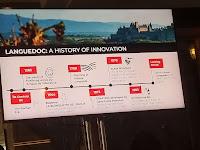
Recently I attended a seminar and wine tasting titled
Languedoc: The New French Wine Scene and presented by
Vins du Languedoc. I thought I knew a lot about the region but in reality - not so much. Thank you Erik Segelbaum. Particularly for informing us of the History of Innovation in Languedoc starting with fortified wines in 1295, sparkling wines in 1544, grafting in 1873, and the recent research into organic and heat-resistant grapes. (more to follow on these innovations)
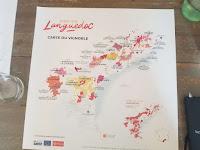
Languedoc is located in southeast France on the Mediterranean and is comprised of 20 AOPs representing 90k+ acres of vines. These vines - representing 26 main grape varieties - receive more than 300 days of sunshine each year and are planted in generally limestone soils along with low-lying scrub and herbal vegetation. The region can be divided into three growing zones: Mediterranean, Atlantic, and Hills & Mountains.
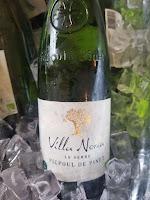

The
Mediterranean or Coastal Plains zone is the warmest with abundant sunshine and mild, wet winters. The soils are mostly limestone with mineral-rich clay and sandstone. Indigenous grapes such as Piquepoul, Bourboulenc, and Clairette thrive in this zone. And that was evident by the
Villa Noria La Serre 2021 ($30) - made from 100% Piquepoul farmed organically in the AOP Picpoul de Pinet region. This wine has more body than others as it is matured on its lees but retains freshness and a strong citrus profile.
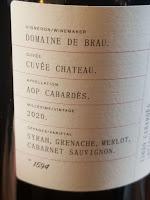

The
Atlantic Zone is much cooler and moist and is shaped by two winds - the crisp and dry Atlantic wind from the west and the warm Mediterranean wind from the east. The coky soil of sandstone and limestone also assists in creating a very distinct terrior. This zone is widely planted with several better-known French varieties, Cabernet, Chardonnay, and Malbec as well as the local Mauzac used in sparkling
Limoux wines. Several domains stood out starting with
Domaine de Brau in AOP Cabardès. Their
Cuvée Château 2020 ($14) is a fresh, but luscious blend of Syrah, Merlot, Grenache, and Cabernet Sauvignon. And their
Etymologie 2020 is a more structured blend of the same grape varieties. An excellent wine.
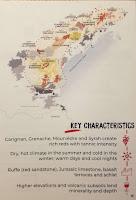

Finally, the
Hills & Mountains zone has a dry and hot climate with longer diurnal cooling. The soils are mostly sandstone and limestone and the higher elevations and volcanic subsoils lead to more mineral-driven wines. The grape varieties planted here are shared with its southern Rhone neighbors - Grenache, Syrah, Mourvedre, and Carignan. Most of the wines poured at this session were from this region and the red blends were in general structured with a fresh, full mouthfeel.
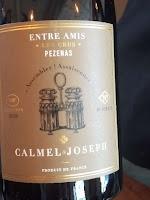
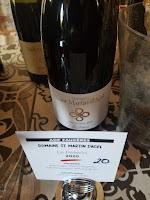 Calmel & Joseph
Calmel & Joseph poured a few wines with the
Entre Amis 2020 ($39) from AOP Languedoc Pézenas as a standout. It is a blend of 40% Syrah, 40% Mourvèdre, & 20% Grenache and think blackberries and figs followed by herbs and a structured finish. The
Terre des 2 Sources Empreintes 2020 had a similar structure and freshness with more red fruit. And their
AOP Terrasses du Larzac Caprices 2019 is a blend of predominately Syrah, then Grenache, and Carignan and has a fresh mouthfeel and brings us back to dark fruit and savory spices. The
Domaine Saint-Martin d'Agel Pèlerin 2020 is a fabulous blend of 45% Syrah, 30% Grenache, 15% Carignan, & 10% Mourvèdre that has velvety red fruit and noticeable minerality. Finally,
Château de Lascaux is a multi-generation family winery - we are talking 14 generations of winegrowers. Today they farm 85 Demeter-certified hectares in AOP Pic Saint-Loup. Their
Carra 2020 ($22) is a GSM blend of 70% Syrah that is plainly delicious with a vibrant mouthfeel and juicy red fruit.
 Recently I attended a seminar and wine tasting titled Languedoc: The New French Wine Scene and presented by Vins du Languedoc. I thought I knew a lot about the region but in reality - not so much. Thank you Erik Segelbaum. Particularly for informing us of the History of Innovation in Languedoc starting with fortified wines in 1295, sparkling wines in 1544, grafting in 1873, and the recent research into organic and heat-resistant grapes. (more to follow on these innovations)
Recently I attended a seminar and wine tasting titled Languedoc: The New French Wine Scene and presented by Vins du Languedoc. I thought I knew a lot about the region but in reality - not so much. Thank you Erik Segelbaum. Particularly for informing us of the History of Innovation in Languedoc starting with fortified wines in 1295, sparkling wines in 1544, grafting in 1873, and the recent research into organic and heat-resistant grapes. (more to follow on these innovations) Languedoc is located in southeast France on the Mediterranean and is comprised of 20 AOPs representing 90k+ acres of vines. These vines - representing 26 main grape varieties - receive more than 300 days of sunshine each year and are planted in generally limestone soils along with low-lying scrub and herbal vegetation. The region can be divided into three growing zones: Mediterranean, Atlantic, and Hills & Mountains.
Languedoc is located in southeast France on the Mediterranean and is comprised of 20 AOPs representing 90k+ acres of vines. These vines - representing 26 main grape varieties - receive more than 300 days of sunshine each year and are planted in generally limestone soils along with low-lying scrub and herbal vegetation. The region can be divided into three growing zones: Mediterranean, Atlantic, and Hills & Mountains.
 The Mediterranean or Coastal Plains zone is the warmest with abundant sunshine and mild, wet winters. The soils are mostly limestone with mineral-rich clay and sandstone. Indigenous grapes such as Piquepoul, Bourboulenc, and Clairette thrive in this zone. And that was evident by the Villa Noria La Serre 2021 ($30) - made from 100% Piquepoul farmed organically in the AOP Picpoul de Pinet region. This wine has more body than others as it is matured on its lees but retains freshness and a strong citrus profile.
The Mediterranean or Coastal Plains zone is the warmest with abundant sunshine and mild, wet winters. The soils are mostly limestone with mineral-rich clay and sandstone. Indigenous grapes such as Piquepoul, Bourboulenc, and Clairette thrive in this zone. And that was evident by the Villa Noria La Serre 2021 ($30) - made from 100% Piquepoul farmed organically in the AOP Picpoul de Pinet region. This wine has more body than others as it is matured on its lees but retains freshness and a strong citrus profile.
 The Atlantic Zone is much cooler and moist and is shaped by two winds - the crisp and dry Atlantic wind from the west and the warm Mediterranean wind from the east. The coky soil of sandstone and limestone also assists in creating a very distinct terrior. This zone is widely planted with several better-known French varieties, Cabernet, Chardonnay, and Malbec as well as the local Mauzac used in sparkling Limoux wines. Several domains stood out starting with Domaine de Brau in AOP Cabardès. Their Cuvée Château 2020 ($14) is a fresh, but luscious blend of Syrah, Merlot, Grenache, and Cabernet Sauvignon. And their Etymologie 2020 is a more structured blend of the same grape varieties. An excellent wine.
The Atlantic Zone is much cooler and moist and is shaped by two winds - the crisp and dry Atlantic wind from the west and the warm Mediterranean wind from the east. The coky soil of sandstone and limestone also assists in creating a very distinct terrior. This zone is widely planted with several better-known French varieties, Cabernet, Chardonnay, and Malbec as well as the local Mauzac used in sparkling Limoux wines. Several domains stood out starting with Domaine de Brau in AOP Cabardès. Their Cuvée Château 2020 ($14) is a fresh, but luscious blend of Syrah, Merlot, Grenache, and Cabernet Sauvignon. And their Etymologie 2020 is a more structured blend of the same grape varieties. An excellent wine. 
 Finally, the Hills & Mountains zone has a dry and hot climate with longer diurnal cooling. The soils are mostly sandstone and limestone and the higher elevations and volcanic subsoils lead to more mineral-driven wines. The grape varieties planted here are shared with its southern Rhone neighbors - Grenache, Syrah, Mourvedre, and Carignan. Most of the wines poured at this session were from this region and the red blends were in general structured with a fresh, full mouthfeel.
Finally, the Hills & Mountains zone has a dry and hot climate with longer diurnal cooling. The soils are mostly sandstone and limestone and the higher elevations and volcanic subsoils lead to more mineral-driven wines. The grape varieties planted here are shared with its southern Rhone neighbors - Grenache, Syrah, Mourvedre, and Carignan. Most of the wines poured at this session were from this region and the red blends were in general structured with a fresh, full mouthfeel. 
 Calmel & Joseph poured a few wines with the Entre Amis 2020 ($39) from AOP Languedoc Pézenas as a standout. It is a blend of 40% Syrah, 40% Mourvèdre, & 20% Grenache and think blackberries and figs followed by herbs and a structured finish. The Terre des 2 Sources Empreintes 2020 had a similar structure and freshness with more red fruit. And their AOP Terrasses du Larzac Caprices 2019 is a blend of predominately Syrah, then Grenache, and Carignan and has a fresh mouthfeel and brings us back to dark fruit and savory spices. The Domaine Saint-Martin d'Agel Pèlerin 2020 is a fabulous blend of 45% Syrah, 30% Grenache, 15% Carignan, & 10% Mourvèdre that has velvety red fruit and noticeable minerality. Finally, Château de Lascaux is a multi-generation family winery - we are talking 14 generations of winegrowers. Today they farm 85 Demeter-certified hectares in AOP Pic Saint-Loup. Their Carra 2020 ($22) is a GSM blend of 70% Syrah that is plainly delicious with a vibrant mouthfeel and juicy red fruit.
Calmel & Joseph poured a few wines with the Entre Amis 2020 ($39) from AOP Languedoc Pézenas as a standout. It is a blend of 40% Syrah, 40% Mourvèdre, & 20% Grenache and think blackberries and figs followed by herbs and a structured finish. The Terre des 2 Sources Empreintes 2020 had a similar structure and freshness with more red fruit. And their AOP Terrasses du Larzac Caprices 2019 is a blend of predominately Syrah, then Grenache, and Carignan and has a fresh mouthfeel and brings us back to dark fruit and savory spices. The Domaine Saint-Martin d'Agel Pèlerin 2020 is a fabulous blend of 45% Syrah, 30% Grenache, 15% Carignan, & 10% Mourvèdre that has velvety red fruit and noticeable minerality. Finally, Château de Lascaux is a multi-generation family winery - we are talking 14 generations of winegrowers. Today they farm 85 Demeter-certified hectares in AOP Pic Saint-Loup. Their Carra 2020 ($22) is a GSM blend of 70% Syrah that is plainly delicious with a vibrant mouthfeel and juicy red fruit.
